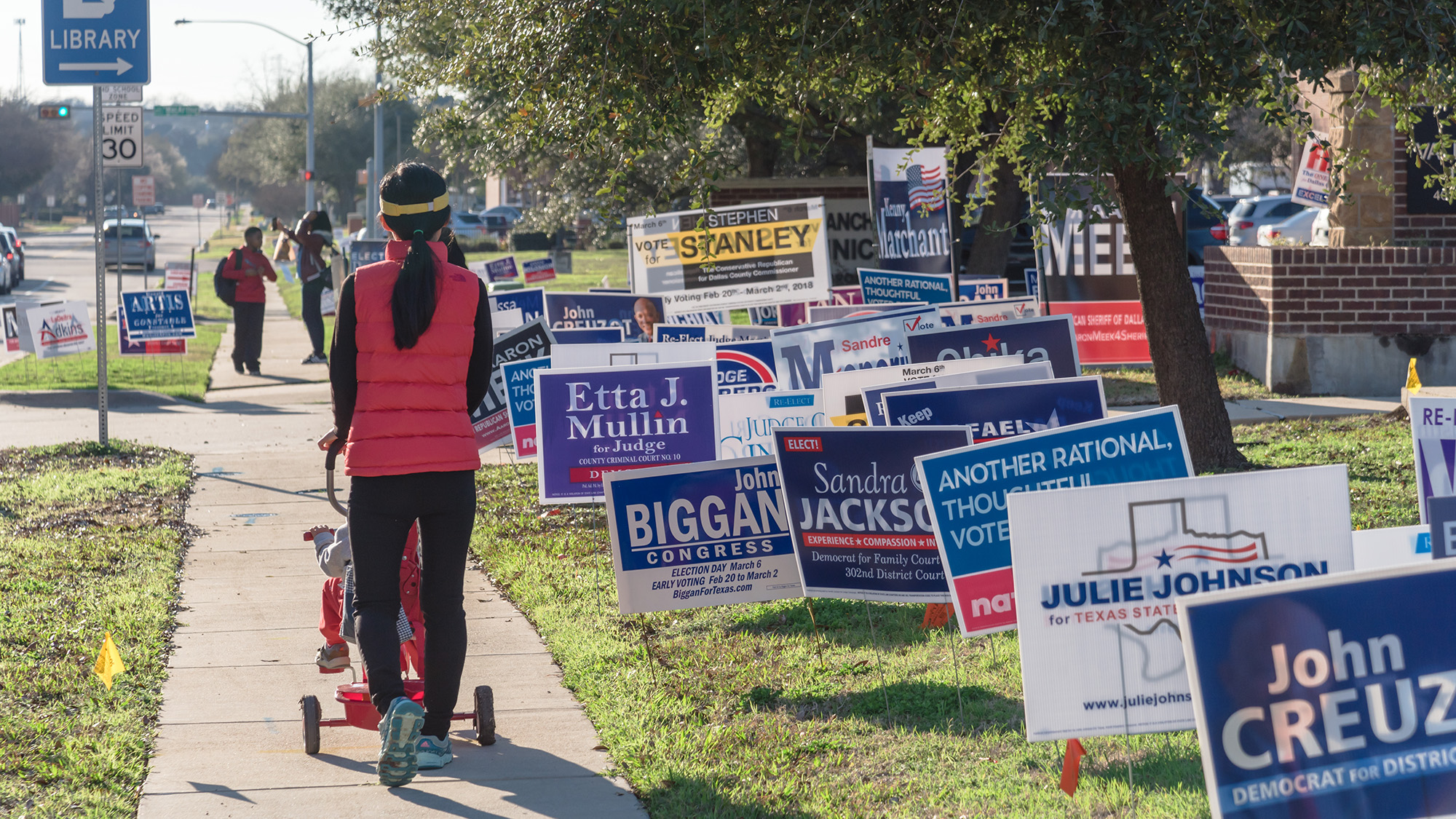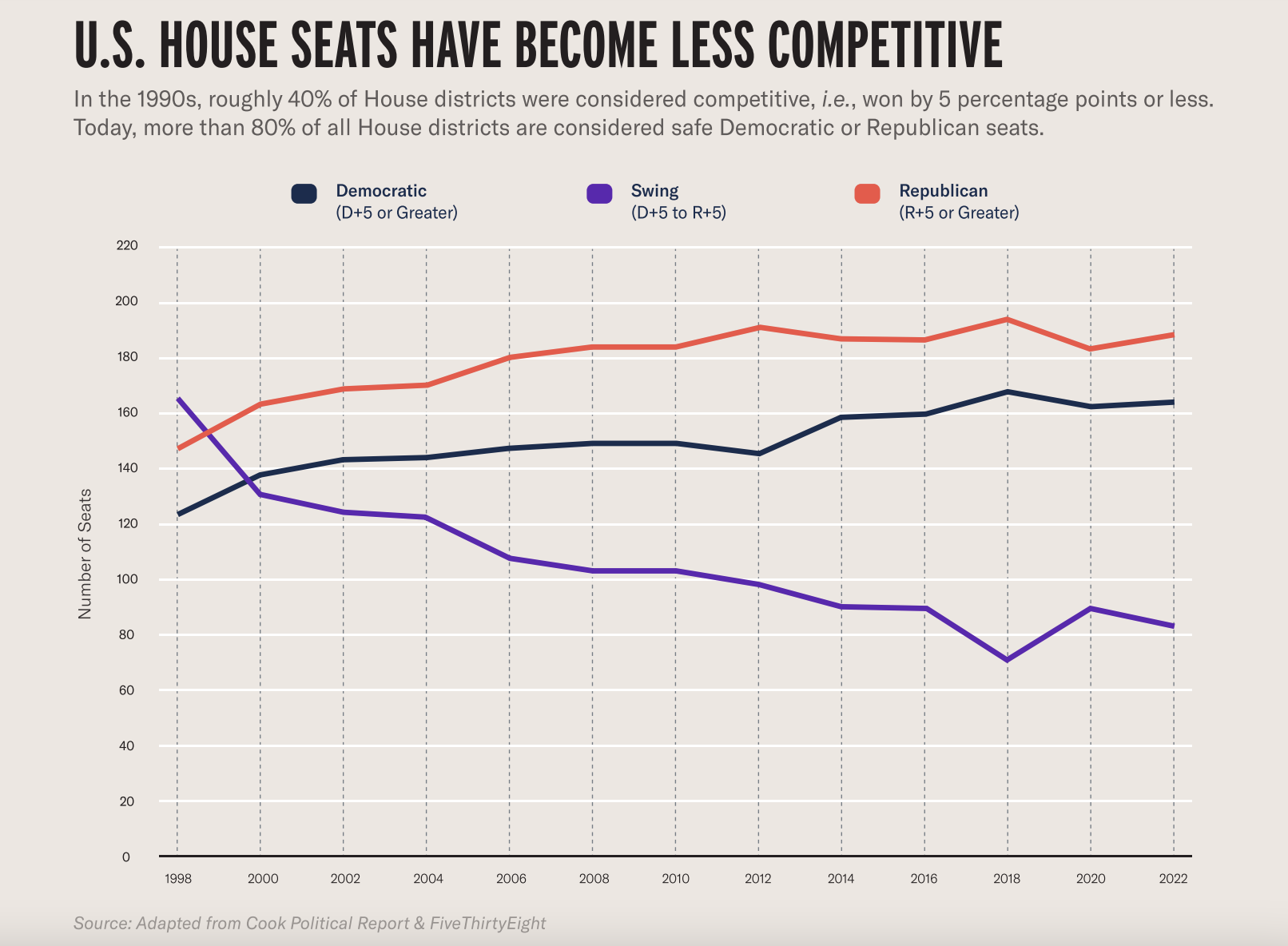Grant Tudor develops and advocates for a range of reforms to shore up our democratic institutions.
Proportional representation & competitiveness
- September 11, 2023
How a more proportional electoral system would increase political competition

Eight percent of U.S. House seats were regarded as “highly competitive” in the November 2022 midterm elections; and only six percent of seats flipped from one party to another.
The decline in competitive districts is in part a function of partisan gerrymandering, which has succeeded at artificially ensuring a higher share of safe districts for one party or another. The decline is also a function of increased geographic sorting, or the more natural clustering of partisans that create “lopsided” districts. As geographic sorting across the U.S. intensifies, such that more “red” and “blue” voters are separately concentrated, the share of districts that favor one party over the other increases. Indeed, even in states that have all but eliminated partisan gerrymandering through independent redistricting commissions — as in Arizona, California, Colorado and Michigan — the vast majority of districts remain uncompetitive.
Adopting a system of proportional representation would likely go far in making more House seats competitive. Our winner-take-all electoral system features a district magnitude of one; proportional systems feature district magnitudes of two or more. And higher district magnitudes — the number of seats per district — address both drivers of decreased competition.

First, higher magnitudes make it difficult, and often impossible, to gerrymander. As Ferran Martínez i Coma and Ignacio Lago conclude from a 2016 survey of 54 democracies: “Not all electoral systems are equally prone to gerrymandering. The problem is inherent in the system of one-seat districts, while it is less serious in [proportional] multimember districts.”
What explains the differences? Proportional multi-member districts make gerrymandering “prohibitively difficult” in practice. The more seats per district, the more difficult it becomes “to predict the exact seat distribution in every district due to the higher number of parties entering the race and the smaller percentages separating winners from losers.” Indeed, after some threshold of seats per district, gerrymandering becomes functionally impossible; as long as a district has at least five seats, it is effectively immune from gerrymandering. Proportional representation could thus structurally weaken or eliminate the practice altogether.
Read more: Towards Proportional Representation for the U.S. House Read more: Towards Proportional Representation for the U.S. House
Second, higher district magnitudes are less sensitive to the spatial distribution of partisans that likewise generates uncompetitive districts. “Unintentional gerrymandering,” where the geographic sorting of partisans tilts a district in one party’s favor, produces the same effects as its more intentional counterpart — and persists even when deliberate gerrymandering has been eliminated. California, which through an independent commission has all but eliminated partisan gerrymandering, is currently estimated to contain only a small handful of competitive congressional districts — out of 52.
This result is simply a function of where voters of different partisan leanings happen to live. Correcting the problem, such as through creative map-drawing decennially, is not only prohibitively difficult, but also comes at steep costs. As Lee Drutman explains, “as long we have single-member districts, and as long as Democrats concentrate in cities while Republicans live outside of the cities, any attempt to redraw districts to make them competitive would require awkwardly connecting slices of city to far-flung patches of country in ways that look even stranger and uglier than the current gerrymanders. Such redistricting would also break apart many identifiable communities.”
* * *
Proportional multi-member districts would structurally decrease the share of “safe” seats for any party, and with no discernable differences in effects between parties. Consider that in single-winner races, a margin of victory greater than five to 10 percent is generally sufficient to qualify the district as uncompetitive, leading the losing party to allocate resources and attention elsewhere, further decreasing competition. In a 60 percent blue district — the product of either gerrymandering, geographic sorting, or both — the likelihood of a Republican victory is small and the seat is effectively “safe” for Democrats. By contrast, imagine combining five neighboring districts that are “safe” for one or the other party into a five-member district. With the outcome for each seat less likely to be a foregone conclusion, parties would be more likely to actively compete for more votes to secure one or more of the seats.
In a 2018 simulation of proportional multi-member districts for the House, the share of competitive seats — whereby voters have a reasonable ability to shift a seat from one major party to the other — increased from 15 percent to 43 percent. By addressing the root causes, proportional representation could go far in reversing the decline in district-level competitiveness between parties.
This analysis is adapted from Towards Proportional Representation for the U.S. House, published by Unite America and Protect Democracy. Read the full report here.
Related Content
It can happen here.
We can stop it.
Defeating authoritarianism is going to take all of us. Everyone and every institution has a role to play. Together, we can protect democracy.
Donate
Sign Up for Updates Sign Up for Updates
Explore Careers Explore Careers
How to Protect Democracy How to Protect Democracy





